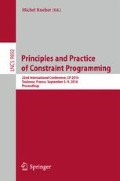Abstract
Predicting protein-protein complexes (protein docking) is an important factor for understanding the majority of biochemical processes. In general, protein docking algorithms search through a large number of possible relative placements of the interacting partners, filtering out the majority of the candidates in order to produce a manageable set of candidates that can be examined in greater detail. This is a six-dimensional search through three rotational degrees of freedom and three translational degrees of freedom of one partner (the probe) relative to the other (the target). The standard approach is to use a fixed step both for the rotation (typically 10\(^\circ \) to 15\(^\circ \)) and the translation (typically 1Å). Since proteins are not isotropic, a homogeneous rotational sampling can result in redundancies or excessive displacement of important atoms. A similar problem occurs in the translational sampling, since the small step necessary to find the optimal fit between the two molecules results in structures that differ by so little that they become redundant. In this paper we propose a constraint-based approach that improves the search by eliminating these redundancies and adapting the sampling to the size and shape of the proteins involved. A test on 217 protein complexes from the protein-protein Docking Benchmark Version 5 shows an increase of over 50 % in the average number of non-degenerate acceptable models retained for the most difficult cases. Furthermore, for about 75 % of the complexes in the benchmark, computation time is decreased by half, on average.
Access this chapter
Tax calculation will be finalised at checkout
Purchases are for personal use only
Notes
- 1.
Or 289 rotation axes, in some previous implementations, depending on exactly how the points are spread with respect to this cutoff for the hemisphere.
- 2.
The square root of the mean of the squared atomic deviations, in Ångstrom.
References
Chen, R., Li, L., Weng, Z.: ZDOCK: an initial-stage protein-docking algorithm. Proteins Struct. Funct. Bioinf. 52(1), 80–87 (2003)
Dominguez, C., Boelens, R., Bonvin, A.M.J.J.: HADDOCK: a protein-protein docking approach based on biochemical or biophysical information. J. Am. Chem. Soc. 125(7), 1731–1737 (2003)
Efron, B.: Bootstrap methods: another look at the jackknife. Ann. Stat. 7(1), 1–26 (1979)
Halperin, I., Ma, B., Wolfson, H., Nussinov, R.: Principles of docking: an overview of search algorithms and a guide to scoring functions. Proteins Struct. Funct. Bioinf. 47(4), 409–443 (2002)
Hura, G.L., Menon, A.L., Hammel, M., Rambo, R.P., Ii, F.L.P., Tsutakawa, S.E., Jenney Jr., F.E., Classen, S., Frankel, K.A., Hopkins, R.C., et al.: Robust, high-throughput solution structural analyses by small angle x-ray scattering (SAXS). Nat. Methods 6(8), 606–612 (2009)
Janin, J.: Assessing predictions of protein-protein interaction: the CAPRI experiment. Protein Sci. 14(2), 278–283 (2005)
Katchalski-Katzir, E., Shariv, I., Eisenstein, M., Friesem, A.A., Aflalo, C., Vakser, I.A.: Molecular surface recognition: determination of geometric fit between proteins and their ligands by correlation techniques. Proc. Nat. Acad. Sci. 89(6), 2195–2199 (1992)
Krippahl, L., Barahona, P.: Applying constraint programming to rigid body protein docking. In: van Beek, P. (ed.) CP 2005. LNCS, vol. 3709, pp. 373–387. Springer, Heidelberg (2005)
Krippahl, L., Barahona, P.: Protein docking with predicted constraints. Algorithms Mol. Biol. 10(1), 9 (2015)
Krippahl, L., Barahona, P.: Symmetry constraints for modelling homo-oligomers. In: 11th Workshop on Constraint Based Methods for Bioinformatics (2015)
Palma, P.N., Krippahl, L., Wampler, J.E., Moura, J.J.: Bigger: a new (soft) docking algorithm for predicting protein interactions. Proteins 39(4), 372–384 (2000)
Roberts, V.A., Thompson, E.E., Pique, M.E., Perez, M.S., Ten Eyck, L.: Dot2: macromolecular docking with improved biophysical models. J. Comput. Chem. 34(20), 1743–1758 (2013)
Saff, E.B., Kuijlaars, A.B.: Distributing many points on a sphere. Math. Intell. 19(1), 5–11 (1997)
Schneidman-Duhovny, D., Inbar, Y., Polak, V., Shatsky, M., Halperin, I., Benyamini, H., Barzilai, A., Dror, O., Haspel, N., Nussinov, R., et al.: Taking geometry to its edge: fast unbound rigid (and hinge-bent) docking. Proteins Struct. Funct. Bioinf. 52(1), 107–112 (2003)
Taylor, J.S., Burnett, R.M.: Darwin: a program for docking flexible molecules. Proteins: Struct. Funct. Bioinf. 41(2), 173–191 (2000)
Vreven, T., Moal, I.H., Vangone, A., Pierce, B.G., Kastritis, P.L., Torchala, M., Chaleil, R., Jiménez-García, B., Bates, P.A., Fernandez-Recio, J., et al.: Updates to the integrated protein-protein interaction benchmarks: Docking benchmark version 5 and affinity benchmark version 2. J. Mol. Biol. 427(19), 3031–3041 (2015)
Acknowledgements
This work was partially supported by funding from FCT MCTES and NOVA LINCS, UID/CEC/04516/2013.
Author information
Authors and Affiliations
Corresponding author
Editor information
Editors and Affiliations
Rights and permissions
Copyright information
© 2016 Springer International Publishing Switzerland
About this paper
Cite this paper
Krippahl, L., Barahona, P. (2016). Constraining Redundancy to Improve Protein Docking. In: Rueher, M. (eds) Principles and Practice of Constraint Programming. CP 2016. Lecture Notes in Computer Science(), vol 9892. Springer, Cham. https://doi.org/10.1007/978-3-319-44953-1_45
Download citation
DOI: https://doi.org/10.1007/978-3-319-44953-1_45
Published:
Publisher Name: Springer, Cham
Print ISBN: 978-3-319-44952-4
Online ISBN: 978-3-319-44953-1
eBook Packages: Computer ScienceComputer Science (R0)

